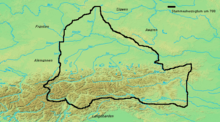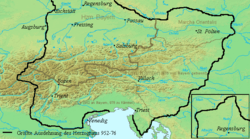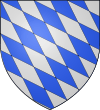Duchy of Bavaria
| Duchy of Bavaria Herzogtum Baiern | |||||
| Stem duchy of the German kingdom State of the Holy Roman Empire (from 962) | |||||
| |||||
 Bavarian lands after 1392 partition | |||||
| Capital | Regensburg (until 1255) Munich (from 1505) | ||||
| Government | Principality | ||||
| Historical era | Medieval Europe | ||||
| - | Margrave Arnulf assumed ducal title |
907 | |||
| - | Split off Duchy of Carinthia |
976 | |||
| - | Split off Duchy of Austria |
1156 | |||
| - | To House of Wittelsbach |
1180 | |||
| - | Raised to Electorate | 1623 | |||
| Today part of | | ||||
The Duchy of Bavaria was originally a frontier region in the southeast of Merovingian kingdom ruled by dukes (duces) under Frankish lordship in the sixth through eighth centuries. In the late ninth century a new duchy was constituted, one of the so-called stem duchies of the Kingdom of Germany and the Holy Roman Empire.
In the Empire, Bavaria was the source of much opposition, especially from the House of Welf between 1070 and 1180. In the final showdown between Duke Henry the Lion and the Hohenstaufen emperor Frederick I, Frederick was triumphant and deprived Henry of his fiefs. Bavaria then passed on to the House of Wittelsbach, which held it until 1918.
Older stem duchy
The origins of the older Bavarian duchy can be traced to the year 551/555. In his Getica the chronicler Jordanes writes: "That area of the Swabians has the Bavarii in the east, the Franks in the west ..." Until the end of the first duchy all rulers descended from the family of the Agilolfings. The Bavarians then colonised the area from the March of the Nordgau along the Naab river (the later Upper Palatinate) up to the Enns in the east and southward across the Brenner Pass to the Upper Adige in present-day South Tyrol. The first documented duke was Garibald, a scion of the Frankish Agilolfings, who ruled from 555 onwards as largely independent Merovingian vassals.
On the eastern border changes occurred with the departure of the East Germanic Lombard tribes from the Pannonian basin to northern Italy (568) and the succession of the Avars, as well as with the settlement of West Slavic Czechs on the adjacent territory beyond the Bohemian Forest at about the same time. At around 743, the Bavarian duke Odilo vassalised the Slavic princes of Carantania (roughly corresponding with the later March of Carinthia), who had asked him for protection against the invading Avars. The residence of the largely independent Agilolfing dukes was then Regensburg, the former Roman Castra Regina, on the Danube river.
During Christianization, Bishop Corbinian laid the foundations for the later Diocese of Freising before 724; Saint Kilian in the 7th century had been a missionary of the Franconian territory in the north, then ruled by the Dukes of Thuringia, where Boniface founded the Diocese of Würzburg in 742. In the adjacent Alamannic (Swabian) lands west of the Lech river, Augsburg was a bishop's seat. When Boniface established the Diocese of Passau in 739, he could already build on local Early Christian traditions. In the south, Saint Rupert had founded in 696 the Diocese of Salzburg, probably after he had baptized Duke Theodo of Bavaria at his court in Regensburg, becoming the "Apostle of Bavaria". In 798 Pope Leo III created the Bavarian ecclesiastical province with Salzburg as metropolitan seat and Regensburg, Passau, Freising and Säben (later Brixen) as suffragan dioceses.
With the rise of the Frankish Empire under the Carolingian dynasty, the autonomy of the Bavarian dukes under the Merovingians was terminated: In 716 the Carolingians had incorporated the Franconian lands in the north formerly held by the Dukes of Thuringia, whereby the bishops of Würzburg gained a dominant position. In the west, the Carolingian mayor of the palace Carloman had suppressed the last Alamannic revolt at the 746 Blood court at Cannstatt. The last tribal stem duchy to be incorporated was Bavaria in 788, after Duke Tassilo III had tried in vain to maintain his independence through an alliance with the Lombards. The conquest of the Lombard Kingdom by Charlemagne entailed the fall of Tassilo, who was deposed in 788. Bavaria was then administrated by Frankish prefects.
Younger stem duchy

In his 817 Ordinatio Imperii, Charlemagne's son and successor Emperor Louis the Pious tried to maintain the unity of the Carolingian Empire: while imperial authority upon his death was to pass to his eldest son Lothair I, the younger brothers were to receive subordinate realms. From 825 Louis the German styled himself "King of Bavaria" in the territory that was to become the centre of his power. When the brothers divided the Empire by the 843 Treaty of Verdun, Bavaria became part of East Francia under King Louis the German, who upon his death bequested the Bavarian royal title to his eldest son Carloman in 876. Carloman's natural son Arnulf of Carinthia, raised in the former Carantanian lands, secured possession of the March of Carinthia upon his father's death in 880 and became King of East Francia in 887. Carinthia and Bavaria were the bases of his power, with Regensburg as the seat of his government.
Due mainly to the support of the Bavarians, Arnulf could take the field against Charles in 887 and secure his own election as German king in the following year. In 899 Bavaria passed to Louis the Child, during whose reign continuous Hungarian ravages occurred. Resistance to these inroads became gradually feebler, and tradition has it that on 5 July 907 almost the whole of the Bavarian tribe perished in the Battle of Pressburg against these formidable enemies.
During the reign of Louis the Child, Luitpold, Count of Scheyern, who possessed large Bavarian domains, ruled the Mark of Carinthia, created on the southeastern frontier for the defence of Bavaria. He died in the great battle of 907, but his son Arnulf, surnamed the Bad, rallied the remnants of the tribe in alliance with the Hungarians and became duke of the Bavarians in 911, uniting Bavaria and Carinthia under his rule. The German king Conrad I unsuccessfully attacked Arnulf when the latter refused to acknowledge his royal supremacy.
Luitpoldings and Ottonians

The Carolingian reign in East Francia ended in 911 when Arnulf's son, King Louis the Child, died without heirs. The discontinuation of the central authority led to a new strengthening of the German stem duchies. At the same time, East Francia was exposed to the rising threat from Hungarian invasions, especially in the Bavarian March of Austria (marchia orientalis) beyond the Enns river. In 907 the army of Luitpold, Margrave of Bavaria suffered a crushing defeat at the Battle of Pressburg. Luitpold himself was killed in action and his son Arnulf the Bad assumed the ducal title, becoming the first Duke of Bavaria from the Luitpolding dynasty. However, the Austrian march remained occupied by the Hungarians and the Pannonian lands were irrecoverably lost.
Nevertheless, the self-confidence of the Bavarian dukes was an ongoing matter of dispute in the newly established Kingdom of Germany: Duke Arnulf's son Eberhard was deposed by King Otto I of Germany in 938; he was succeeded by his younger brother Berthold. In 948, King Otto finally disempowered the Luitpoldings and installed his younger brother Henry I as Bavarian duke. The late Duke Berthold's minor heir, Henry III, was fobbed off with the office of a Bavarian Count palatine. The last attempt of the Luitpoldings to regain power by joining the rebellion of King Otto's son Duke Liudolf of Swabia was crushed in 954.
In 952 Duke Henry I also received the Italian March of Verona, which Otto I had seized from King Berengar II of Italy. He still had to deal with the Hungarian threat, which was not eliminated until King Otto's victory at the 955 Battle of Lechfeld. The Magyars retreated behind the Leitha and Morava rivers, facilitating a second wave of German Ostsiedlung into the areas of today's Lower Austria, Istria and Carniola. Although ruled by the Ottonian descendants of Henry I, a cadet branch of the Saxon royal dynasty, the conflict of the Bavarian dukes with the German (from 962: Imperial) court continued: in 976, Emperor Otto II deposed his rebellious cousin Duke Henry II of Bavaria and established the Duchy of Carinthia on former Bavarian territory granted to the former Luitpolding Count palatine Henry III, who also became Margrave of Verona. Though Henry II reconciled with Emperor Otto's widow Theophanu in 985 and regained his duchy, the power of the Bavarian dukes was further diminished by the rise of the Franconian House of Babenberg, ruling as Margraves of Austria (Ostarrichi), who became increasingly independent.
House of Welf
The last Ottonian duke, Henry II's son Henry III, was elected King of the Romans in 1002. At different times the duchy was ruled by the German kings in personal union, by dependent dukes, or even by the emperor's sons, a tradition maintained by Henry's Salian successors. This period saw the rise of many aristocratic families, such as the Counts of Andechs or the House of Wittelsbach. In 1061 the dowager empress Agnes of Poitou enfeoffed the Saxon count Otto of Nordheim. Nevertheless, her son King Henry IV again seized the duchy on fallacious grounds, which ultimately led to the Saxon Rebellion of 1073. Henry entrusted Bavaria to Welf, a scion of the Veronese margravial House of Este and progenitor of the Welf dynasty, which intermittently ruled the duchy for the next 110 years.
Only with the establishment of Guelph rule as dukes from 1070 by Henry IV was there a re-emergence of the Bavarian dukes. This period is characterized by the Investiture Controversy between Emperor and Pope. It strengthened Guelph rule through siding with the pope's position.
A conflict with the Swabian dynasty of Hohenstaufen in the election of the king led the discretion of the Hohenstaufen Conrad III to the king but to the fact that Bavaria was given to the Babenbergs 1139. The Swabian area was during the reign of the Staufer king largely countryside. Increasingly, Franconia also became the center of Staufer power. Franken obtained a dominant position of the Bishop of Würzburg by the founding of the diocese of Bamberg, and new secular rulers lost 1007th The Hohenstaufen Frederick I Barbarossa attempted reconciliation with the Guelphs[1] and in 1156 gave back the Marcha Orientalis scaled to Bavaria the Guelph Henry the Lion.
The detached Marcha Orientalis was the Babenbergs as the new Duchy of special privileges to the nucleus of the later Austria (Ostarrichi). Henry the Lion founded numerous cities, including Munich in 1158. Through his strong position as ruler of the two duchies of Saxony and Bavaria he came into conflict with Frederick I Barbarossa. With the banishment of Henry the Lion and the separation of Styria as a private duchy in 1180 the younger tribal duchy came to an end.
Imperial State
From 1180 to 1918, the Wittelsbachs were the rulers of Bavaria, as dukes, later as electors and kings. When Count Palatine Otto VI. of Wittelsbach became Otto I, Duke of Bavaria in 1180, the Wittelsbach treasury was rather low. In the following years it was significantly augmented by purchase, marriage, and inheritance. Newly acquired land was no longer given as a fief, but managed by servants. Also, powerful families, such as the counts of Andechs, died out during this period. Otto's son Ludwig I of Wittelsbach was enfeoffed in 1214 with the County of Palatine of the Rhine.
Since there was no preference for succession of the firstborn in the Wittelsbach dynasty, in contrast to many governments of this time, there was in 1255 a division of the land into Upper Bavaria with the Palatinate and the Nordgau (headquartered in Munich) and lower Bavaria (with seats in Landshut and Burghausen). There is still today a distinction made between upper and lower Bavaria (cf. Regierungsbezirke) .
Despite renewed division after a short time of reunification, Bavaria gained new heights of power with Louis IV, Holy Roman Emperor, who became the first Wittelsbach emperor in 1328. The newly gained areas of Brandenburg (1323), Tyrol (1342), the Dutch provinces Holland, Zeeland and Friesland and the Hainaut (1345) were, however, lost under his successors. In 1369, Tyrol fell through the Treaty of Schärding to the Habsburgs. The Luxemburgish rider followed in 1373 and the Dutch counties fell to Burgundy in 1436. In the 1329 Treaty of Pavia, Emperor Louis divided ownership in a Palatine region, with the Rhine Palatinate, and a later so-called Upper Palatinate. Thus, the electoral dignity for the line onwards to the Palatinate was also lost. With the recognition of the limits of domination by the Bavarian Duke in the year 1275, Salzburg of Bavaria went into their final phase. When the Salzburg Archbishop issued its own country regulations in 1328, Salzburg become a largely independent state within the Holy Roman Empire.
In the 14th and 15th centuries, upper and lower Bavaria were repeatedly subdivided. Four Duchies existed after the division of 1392: Lower Bavaria-Straubing, lower Bavaria-Landshut, Bavaria-Ingolstadt and Bavaria-Munich. These dukes often waged war against each other. Duke Albrecht IV of Bavaria-Munich united Bavaria in 1503 through primogeniture and war. However, the originally Bavarian offices Kufstein, Kitzbühel and Rattenberg in Tirol were lost in 1504.
References
- ↑ Görich, Knut: Die Staufer. Herrscher und Reich. Munich 2006. p. 41.
| |||||||||||||
| ||||||||||||||
| |||||||



.svg.png)